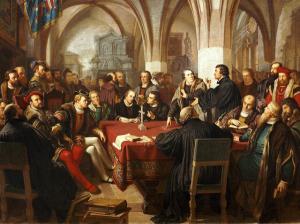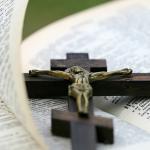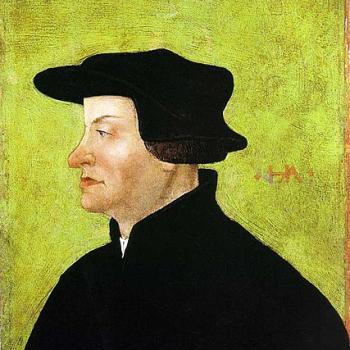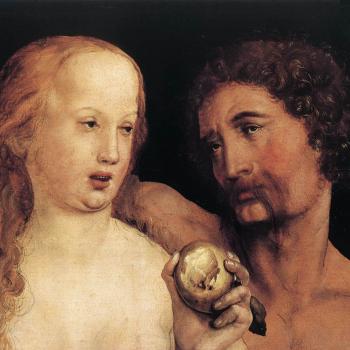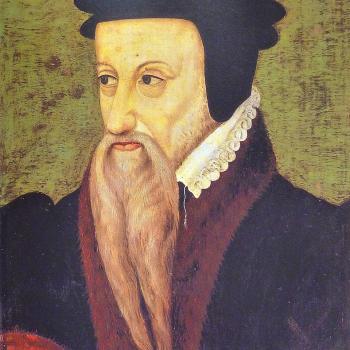+ How Early Protestants Widely Damned Other Protestants Who Held Different Theological Views
Dr. Gavin Ortlund is a Reformed Baptist author, speaker, pastor, scholar, and apologist for the Christian faith. He has a Ph.D. from Fuller Theological Seminary in historical theology, and an M.Div from Covenant Theological Seminary. Gavin is the author of seven books as well as numerous academic and popular articles. For a list of publications, see his CV. He runs the very popular YouTube channel Truth Unites, which seeks to provide an “irenic” voice on theology, apologetics, and the Christian life. See also his website, Truth Unites and his blog.
In my opinion, he is currently the best and most influential popular-level Protestant apologist, who (especially) interacts with and offers thoughtful critiques of Catholic positions, from a refreshing ecumenical (not anti-Catholic) but nevertheless solidly Protestant perspective. That’s what I want to interact with, so I have made many replies to Gavin and will continue to do so. His words will be in blue.
*****
This is a response to one erroneous statement in Gavin’s video, “The 5 Minute Case for Protestantism” (6-8-23).
There is indeed one universal church of the faithful outside of which no one at all is saved, . . .*The sacrament of baptism (which is celebrated in water at the invocation of God and of the undivided Trinity, that is, the Father, the Son, and the Holy Spirit) conduces to the salvation of children as well as of adults when duly conferred by anyone according to the Church’s form. If someone falls into sin after having received baptism, he or she can always be restored through true penitence. For not only virgins and the continent but also married persons find favour with God by right faith and good actions and deserve to attain to eternal blessedness. (Fourth Lateran Council, chapter 1: “The Catholic Faith”; pp. 266-267)*That there is only one, holy, catholic, and apostolic Church we are compelled by faith’s urging to believe and hold, and we firmly believe in her firmly and sincerely her outside of whom there is neither salvation nor remission of sins . . . and she represents the one mystical body. . . .*[W]e declare, we proclaim, we define that it is absolutely necessary for salvation that every human creature be subject to the Roman Pontiff. (Unam Sanctam, pp. 286-287)*She firmly believes, professes, and preaches that “none of those who are outside of the Catholic Church, not only pagans,” but also Jews, heretics, and schismatics, can become sharers in eternal life, but they will go into the eternal fire “that was prepared for the devil and his angels” [Mt 25:41] unless, before the end of their life, they are joined to her. And the unity of the Church’s body is of such great importance that the Church’s sacraments are beneficial toward salvation only for those who remain within her, and [only for them] do fasts, almsgiving, and other acts of piety and exercises of Christian discipline bring forth eternal rewards. “No one can be saved, no matter how many alms he has given, and even if he sheds his blood for the name of Christ, unless he remains in the bosom and unity of the Catholic Church.” (Council of Florence, Cantate Domino; the two non-scriptural citations come from Fulgentius of Ruspe [462 or 467 to 527 or 533]; pp. 348-349)
1) We believe that there are those who are members of His Body who don’t know it. We know, for example, that there were plenty of righteous folks saved before Christ came into the world. These people didn’t know who Jesus Christ was, by that name. . . .*2) Some might even expressly deny being members of His Body, out of confusion and forgivable error, and still be part of the Body. St. Paul, in 1 Corinthians 12:15-16, says as much:
If the foot should say, “Because I am not a hand, I do not belong to the body,” it would not for that reason cease to be part of the body. And if the ear should say, “Because I am not an eye, I do not belong to the body,” it would not for that reason cease to be part of the body.
The other criticism is that this theory is some sort of clever ruse to get out of the seemingly plain language of Unam Sanctum. It’s not. At the same time things like the bull of Unam Sanctum were being promulgated, the papacy recognized the validity of the Eastern Orthodox sacraments (as it always has, even when the mutual excommunications were in place). Where there are valid sacraments, there is the Church. So even though the Eastern Orthodox weren’t, and aren’t, in full Communion, they’re in some sort of Communion sufficient enough to have valid sacraments, and to receive the Eucharist at Mass should they so desire. (“Is There Salvation Outside of the Church? And Other Questions.,” Shameless Popery, 6-4-10)
The best example of the Church simultaneously acknowledging that She is a visible, structured society and that some outside Her physical bounds will be saved is at the Fourth Council of Lateran in 1215 A.D. Her focus there was very much on the Eastern Orthodox, . . .*She is describing a visible and organized Church, with an earthly head, the Roman Pontiff (Canon 5), outside of which there is no salvation (Canon 1). Yet she is simultaneously acknowledging that the disobedient Eastern Orthodox are still validly priests, and still validly offer the Eucharist (Canon 4). . . .*And, of course, they have valid Baptism. The sacrament of Baptism is even more expansive than the sacrament of the Eucharist, in that anyone can offer it, provided they do so faithfully and correctly (Canon 1). And this sacrament leads to salvation. So without question, the Eastern Orthodox may be saved. . . .*The Fourth Lateran Council is important, because it expresses simultaneously that there is no salvation outside of the visible Church, and that some are saved who are not visibly within the Church. Most papal documents and Patristic writings address only one or the other, and thus look like contradictions. . . .*There are two Church documents, both likely infallible, which are frequently misrepresented in the context of this discussion. The first is the papal bull Unam Sanctam (1302), which declares the same thing that the Fourth Lateran Council declared, but more forcefully: “Furthermore, we declare, we proclaim, we define that it is absolutely necessary for salvation that every human creature be subject to the Roman Pontiff. ” This statement is easily the most controversial on the subject, since Protestants and Orthodox don’t think they’re subject to the Roman Pontiff. But those who are saved are subject nonetheless. The most direct way of showing this is through logic:
*
- Everyone who is saved, is saved through Christ and His Church, whether they know it or not.
- Everyone who is saved is saved during this lifetime – there are no second-chances in the afterlife.
- The head of the Church on Earth is the Roman Pontiff.
- Therefore, everyone saved is saved by spiritual membership in the Church Militant, in which they are subject to the Pope. . . .
*The pope isn’t saying that every saved person is knowingly subject to the Roman Pontiff, or even aware of who he is. . . .*It isn’t necessary to salvation to be juridically connected to the Church. (“Salvation Outside of the Church,” Shameless Popery, 8-12-10)
The Church has always held both: (1) that the Church is an indispensable part of salvation, such that you cannot be saved without Her (since Christ has but one Body and one Bride); and (2) that some will be saved without express membership in the Church. The teachings are in seeming tension (just as “One God,” and “Three Persons” are in seeming tension), but they don’t contradict. . . . This isn’t some new modern teaching: in the earlier, more exhaustive post, I quoted St. Justin Martyr, who spoke of how Socrates seemed an atheist to his peers, but was spiritually a follower of the Christ he didn’t know by Name. So this isn’t a “development” at all: it’s the clear teaching of Tradition. It’s only a contradiction if you claim that visible union is required, which . . . the Church doesn’t (and in fact, condemns as heresy). (“Why Mathison is Wrong on Salvation Outside the Church,” Shameless Popery, 8-17-10)
The Church is a mother because it is her privilege to bring forth into the world the spiritual children of the Lord Jesus Christ. The Church is left in the world still that she may bring out the rest of God’s elect that are still hidden in the caverns and strongholds of sin. If God had willed it, he might have brought out all his children by the mere effort of his own power, without the use of any instrumentality. He might have sent his grace into each individual heart in some such miraculous manner as he did into the heart of Saul, when he was going toward Damascus; but he hath not chosen to do so. He, who hath taken the Church to be his spouse and his bride, has chosen to bring men to himself by means; and thus it is, through God’s using the Church, her ministers, her children, her works, her sufferings, her prayers, — through making these the means of the increase of his spiritual kingdom, she proves her right to take to herself the title of mother. (“The Church a Mother,” April 8, 1860, from Metropolitan Tabernacle Pulpit, Volume 48)
Outside this Christian Church there is no salvation or forgiveness of sins, but everlasting death and damnation. (Confession Concerning Christ’s Supper, Feb. 1528, Luther’s Works, Vol. 37, 368)
*[O]utside the Christian church there is no truth, no Christ, no salvation. (The Gospel for the Early Christmas Service, 1522, Luther’s Works, Vol. 52, 40)
*
[B]eyond the pale of the Church no forgiveness of sins, no salvation, can be hoped for, as Isaiah and Joel testify (Isa. 37:32; Joel 2:32). . . . the abandonment of the Church is always fatal. (Institutes of the Christian Religion, IV, 1:4)
*[T]he Lord has not promised his mercy save in the communion of saints. (Ibid., IV, 1:20)*
Now I’d like to make a second argument that stands alongside the first. Catholics believe that anyone baptized in a trinitarian formula, by anyone who intends what the Catholic Church does in its sacrament of baptism is regenerated, receives a host of spiritual benefits, and is, therefore, a member of the Body of Christ, and will be saved, short of lapsing into unrepentant and unconfessed mortal sin. This, too, undeniable, and it utterly refutes Gavin’s false claim, seen at the top of this article. The best summary I have seen of the spiritual benefits of baptism is this piece from my mentor, Servant of God, Fr. John A. Hardon, S.J.:
BAPTISMAL GRACES
The supernatural effects of the sacrament of baptism. They are: 1. removal of all guilt of sin, original and personal; 2. removal of all punishment due to sin, temporal and eternal; 3. infusion of sanctifying grace along with the theological virtues of faith, hope, and charity, and the gifts of the Holy Spirit; 4. incorporation into Christ; and 5. entrance into the Mystical Body, which is the Catholic Church; 6. imprinting of the baptismal character, which enables a person to receive the other sacraments, to participate in the priesthood of Christ through the sacred liturgy, and to grow in the likeness of Christ through personal sanctification. Baptism does not remove two effects of original sin, namely concupiscence and bodily mortality. However, it does enable a Christian to be sanctified by his struggle with concupiscence and gives him the title to rising in a glorified body on the last day. (Modern Catholic Dictionary [Garden City, New York: Doubleday & Co., 1980], “Baptismal Graces,” 53)
All of this, leading to salvation itself, is what the Catholic Church claims is true of all validly baptized Protestants and Orthodox (just as it is of Catholics). And it did so in the Middle Ages at least as early as 1230 years before Trent, which again reiterated the teaching in its Decree on Sacraments; On Baptism; Canon IV: “If any one saith, that the baptism which is even given by heretics in the name of the Father, and of the Son, and of the Holy Ghost, with the intention of doing what the Church doth, is not true baptism; let him be anathema.” (7th Session, March 1547). But the general teaching was in place long before that. By this reasoning, St. Augustine opposed the “rebaptism” of schismatic Donatists who returned to the Catholic Church. In 256, 1261 years before the advent of Protestantism and 1289 years before the Council of Trent began, Pope Stephen I wrote a letter to the bishops of Asia Minor (Bishop Firmilian of Caesarea / Cappadocia reported his words):
Stephen and those who agree with him contend that the forgiveness of sins and the second birth [regeneration] can also be obtained in the baptism of the heretics, . . . (DS 111, p. 46)
[I]f anyone comes into the Church from heresy, he should be questioned on the profession of faith, and if it be determined that he has been baptized in [the name of] the Father and the Son and the Holy Spirit, only hands should be imposed on him, so that he may receive the Holy Spirit . . . (DS 123, p. 50)
According to the most sacred custom of the Catholic Church, no share in the injury from the name of Acacius [Patriarch of Constantinople, who initiated the Acacian schism of 484-519] should attach to any of those whom Acacius the schismatic bishop has baptized, . . . lest perchance the grace of the sacrament seem less powerful . . . For baptism . . . even if administered by an adulterer or by a thief accomplishes its purpose by undiminished reception . . . (DS 356, p. 127)
There is nothing left to prove in this respect. Gavin’s statement has been utterly refuted. It’s a falsehood. Nothing personal! I like Gavin, but he simply didn’t have enough knowledge to properly make the statement that he made. If he reads this article, however, he will, and he would then be duty-bound to retract it as a misrepresentation of medieval Catholic teaching. He has repeatedly stated in his videos that all Christians ought to do their best to accurately present the teachings of other Christians with whom they disagree. Heaven knows, there is more than enough of failing to do that on both sides. Here is his chance to follow his own worthy admonition.
Since they regard us as “un-Christians” whom the Spirit of God has forsaken . . . (LW, 37, 21)
Besides, we godless and unforbearing “un-Christians” must put up with having these holy and moderate teachers revile us as idolaters and having our God called the baked God, the edible and potable God, the bread-God, the wine-God, and ourselves called God-forsaken Christians and such names. This altogether venomous, devilish abuse exceeds all bounds. Now a person would rather be upbraided for being full of devils than have a “baked God.” (37, 22)
Since we “un-Christians” and unforbearing heathen, I say, must suffer such horrible slander and shameful vilification from them, they, as the holy Christians . . . they regard me as full of devils. (37, 23)
The footnotes document these charges:
19 Oecolampadius: “If the real, true Spirit of God has not forsaken you now . . .” Reasonable Answer. St. L. 20, 599. He frequently applied Gal. 4:9 to his adversaries: “They turn back from Christ to the [weak and beggarly] elements.” Apologetics, 1526 M 7 f. Zwingli wrote on April 5, 1525, that his adversaries in the Lord’s supper controversy “are not led by the same Spirit.” C.R. 95, 317. Bucer: “Let Luther acknowledge that he is being led by a spirit far different from that of Christ.” Preface, 1527. St. L. 17, 1601. Luther and his party are frequently admonished to pray for God’s Spirit (cf. Bucer, ibid.), which the Swiss and Strassburgers claim has been revealed to them. Oecolampadius, Apologetics, H 4; Bucer, Apology, 1526, 35). See Luther’s Letter to Spalatin, March 27, 1526, . . . (37, 21)
24 Zwingli compared “worshiping the consecrated bread” with the worship of the golden calf at Dan (I Kings 12:28 f.). Letter to Matthew Alber, published 1525. C.R. 90, 342; St. L. 17, 1520. He ridiculed the Lutherans’ “edible, impanated, baked, roasted, ground-up God.” Reply to Urban Rhegius. C.R. 91, 934. Oecolampadius defended the epithet, “eaters of God’s flesh and drinkers of God’s blood,” in Reasonable Answer. St. L. 20, 588. Cf. Luther’s Letter to Gregory Casel, November 1525. (37, 22)
So here we have the surreal spectacle of these so-called “reformers” Zwingli, Bucer, and Oecolampadius, classifying Luther, the founder of Protestantism, and Lutherans, within four years of the Diet of Worms, as non-Christians. And this is the unifying force of Christianity, over against Catholicism? Luther returned the favor (Catholics admire and applaud his efforts to defend the Real Presence in the Eucharist in this treatise):
Our adversary says that mere bread and wine are present, not the body and blood of the Lord. If they believe and teach wrongly here, then they blaspheme God and are giving the lie to the Holy Spirit, betray Christ, and seduce the world. One side must be of the devil, and God’s enemy. There is no middle ground. . . . These fanatics demonstrate forthrightly that they regard the words and works of Christ as nothing but human prattle . . . (LW, vol. 37, 36)
[W]e intend to shun, condemn, and censure them, as idolaters, corrupters of God’s Word, blasphemers, and liars . . . (37, 27)
[W]hat shall I say of the outrageous audacity of this hellish Satan [Oecolampadius]? (37, 127)
[H]e who deliberately denies, blasphemes, and desecrates Christ in one subject or article cannot correctly teach or honor him at any other point; it is sheer hypocrisy and deception, . . . one either loses Christ completely, or has him completely. (37, 131)
In his work, Brief Confession Concerning the Holy Sacrament, written in September 1544, Luther calls Zwingli, Karlstadt, Oecolampadius, and Caspar Schwenkfeld (on whose name Luther does a play on words throughout his tract, making it mean “Stinkfield”) -– and by implication those who believe as they do — an “accursed faction of fanatics, Zwinglians and the like” (LW, 38, 287), who adhere to a “blasphemous and deceitful heresy” (38, 288), “murderers of souls” (38, 296), who “possess a bedeviled, thoroughly bedeviled, hyper-bedeviled heart and lying tongue” (38, 296), and who “have incurred their penalty and are committing ‘sin which is mortal’,” (38, 296), “blasphemers and enemies of Christ” (38, 302), and “God’s and our condemned enemies” (38, 316). He described Zwingli as a “full-blown heathen” (38, 290), and wrote: “I am certain that Zwingli, as his last book testifies, died in a great many sins and in blasphemy of God” (38, 302-303).
Luther felt that he was duty-bound to separate himself from them: “I must leave them to their devices and avoid them as the ‘self-condemned’ [auto-katakritos, Titus 3:11] who knowingly and intentionally want to be condemned. I must not have any kind of fellowship with any of them . . .” (38, 304); “I would have to condemn myself into the abyss of hell together with them if I should make common cause with them or have fellowship with them . . .” (38, 305).
But John Calvin, in his Letter to the Pastors of Zurich, Berne, Basle, etc. (28 November 1554), thought that Zwingli and Oecolampadius were “two excellent doctors, . . . who were known to be faithful servants of Jesus Christ.”
I’ve written recently again about how both Lutherans and Calvinists persecuted their fellow Protestant Anabaptists to the death, for holding to adult believer’s baptism and other doctrines that they disagreed with.
One might think that the John Calvin and his Calvinists only went after the Catholic Mass as rank idolatry. One would be wrong if so. They also attacked Lutherans as idolaters. Hence, John Calvin (1509-1564) wrote to Bucer:
In their madness they even drew idolatry after them. For what else is the adorable sacrament of Luther but an idol set up in the temple of God? (Letter to Martin Bucer, June 1549; in Jules Bonnet, editor, John Calvin: Selected Works of John Calvin: Tracts and Letters: Letters, Part 2, 1545-1553, volume 5 of 7; translated by David Constable; Grand Rapids: Baker Book House, 1983; reproduction of Letters of John Calvin, volume II [Philadelphia: Presbyterian Board of Publication, 1858], p. 234)
Calvin wrote to Philipp Melanchthon (1497-1560): Luther’s right-hand man and successor on 28 November 1552, summing up the scandalous Protestant chaos:
But it greatly concerns us to cherish faithfully and constantly to the end the friendship which God has sanctified by the authority of his own name, seeing that herein is involved either great advantage or great loss even to the whole Church. For you see how the eyes of many are turned upon us, so that the wicked take occasion from our dissensions to speak evil, and the weak are only perplexed by our unintelligible disputations. Nor in truth, is it of little importance to prevent the suspicion of any difference having arisen between us from being handed down in any way to posterity; for it is worse than absurd that parties should be found disagreeing on the very principles, after we have been compelled to make our departure from the world. . . .
And surely it is indicative of a marvellous and monstrous insensibility, that we so readily set at nought that sacred unanimity, by which we ought to be bringing back into the world the angels of heaven. Meanwhile, Satan is busy scattering here and there the seeds of discord, and our folly is made to supply much material. At length he has discovered fans of his own, for fanning into a flame the fires of discord. I shall refer to what happened to us in this Church, causing extreme pain to all the godly; and now a whole year has elapsed since we were engaged in these conflicts. . . (Selected Works of John Calvin: Tracts and Letters: Letters, Part 2, 1545-1553, vol. 5 of 7; edited by Jules Bonnet, translated by David Constable; Grand Rapids, Michigan: Baker Book House [Protestant publisher], 1983, 454 pages; reproduction of Letters of John Calvin, vol. 2 (Philadelphia: Presbyterian Board of Publication, 1858; the letter in question is numbered as CCCV [305] and is found on pp. 375-381; the portion above is from pp. 376-377).
Melanchthon wrote (educated guess) in the next month:
If my eyes were a fountain of tears, as rich as the waters of the river Elbe, I could not sufficiently express my sorrow over the divisions and distractions of Christendom. (from: The New American Cyclopaedia, edited by George Ripley and Charles Anderson Dana, New York: D. Appleton and Co., 1861, Vol. 11, “Melanchthon,” p. 361; primary source: Epistles, Book 4, epistle 100 [Dec. 1552?]; see the same exact quote in The Unitarian Review of 1874, pp. 450-451 and American Presbyterian Review, Vol. 1, 1869, pp. 248-249)
In a letter to William Farel in August, 1557, Calvin opines:
With regard to [Joachim] Westphal [a Lutheran] and the rest, it was difficult to follow your advice and be calm. You call those “brothers,” who, if that name be offered to them by us, do not only reject, but execrate it. And how ridiculous should we appear in bandying the name of brother with those who look upon us as the worst of heretics!
And in another to Bullinger about the same time we find:
You shall judge how dexterously I have treated the Saxons. . . . I know that I shall excite the hatred of them all . . . I have, indeed, not hesitated cheerfully and fearlessly to provoke the fury of those beasts against me, because I am confident that it will be pleasing to God! (this letter and the above from Thomas Henry Dyer, The Life of John Calvin, New York: Harper & Brothers, 1850, pp. 336-337)
In the year before he died, Calvin described Lutheranism as an “evil”:
I am carefully on the watch that Lutheranism gain no ground, nor be introduced into France. The best means, believe me, for checking the evil would be that confession written by me . . . (Letter to Heinrich Bullinger, 2 July 1563, in John Dillenberger, editor, John Calvin: Selections From His Writings, Garden City, New York: Doubleday & Co. [Anchor Books], 1971, 76)
Then of course, there were the never-ending battles in Protestantism between Calvinists and Arminians, which continue to this day. This was not — and is not — just a friendly gentleman’s agreement. In the Synod of Dort in the Netherlands in 1618-1619, the Arminians were declared to be heretics because they disagreed with the specifically Calvinist doctrines, such as “TULIP”: the Five Points of Calvinism. Lest someone think that this was not an accusation of heresy (with the implication that Arminians were not Christians at all), here is how the Center for Reformed Theology and Apologetics website summed up the verdict of the synod:
Dordt stated that in reaction to the Arminian and Remonstrant Articles and Opinions, that Arminius and the Remonstrants, “summon back from hell the Pelagian error.”[1] They said that Arminianism “deceive(s) the simple,”[2] “is an invention of the human brain,”[3] is a “pernicious error,”[4] “smacks of Pelagius,”[5] “runs counter to the entire Scripture,”[6] is “gross error,”[7] “militate(s) against the experience of the saints and is contrary to Scripture,”[8] “contradict(s) Scripture,”[9] “attempt(s) to give the people the deadly poison of Pelagianism,”[10] “contradict(s) the apostle” and “contradict(s) the Savior,”[11] “is an insult to the wisdom of God,”[12] “is opposed to the plain testimonies of Scripture,”[13] “is a teaching that is entirely Pelagian and contrary to the whole of Scripture.”[14] Christians should know that “the early church already condemned this doctrine long ago in the Pelagians,”[15] “is obviously Pelagian,”[16] and “nullifies the very grace of justification and regeneration.”[17]
The orthodox professors, theologians, and ministers of Holland and England sought incessantly to suppress the teaching of the Arminians and to prohibit the exercise of that faith which they were firm in condemning as heretical. This they were able to do quite effectively by the convening of the Synod of Dort. Arminianism, for these reasons, has always been viewed as not only error, but heresy.
[1] Canon 2 Article 3
[2] Canon 1 Article 1
[3] Canon 1 Article 2
[4] Canon 1 Article 3
[5] Canon 1 Article 4
[6] Canon 1 Article 5 and Canon 3 Article 4
[7] Canon 1 Article 6
[8] Canon 2 Article 1
[9] Canon 2 Article 4
[10] Canon 2 Article 6
[11] Canon 2 Article 7
[12] Canon 3 Article 1
[13] Canon 4 Article 4
[14] Canon 3 Article 7
[15] Canon 3 Article 9
[16] Canon 5 Article 2
[17] Canon 5 Article 3 (from: “The Synod of Dordt Condemned Arminianism as Heresy,” May 8, 2020)
Since the great majority of even Protestantism today is not Calvinist, and Protestantism is a minority among all Christians, in effect these decrees define the vast majority of Christians today and all through history as Pelagian heretics.
If all of this division, rancor, and chaos (that caused Luther, Melanchthon, and Calvin no end of personal anguish and agony, by their own frequent reports) is supposedly blessed Christian unity, and the highest, most spiritual expression of the catholicity of Christianity, and evidence of the sublimity of the Protestant “reform” as morally and biblically superior to what came before, I’ll most gladly remain a Catholic, thank you.
*
Related Reading
*
Is There Salvation Outside the Catholic Church? (1893 book by Catholic theologian Jean Vincent Bainvel, S.J. [1858-1937], professor of fundamental theology at the Institut Catholique de Paris). Read online for free.
Is There Salvation Outside the Church? (Fr. William G. Most) [Catholic Culture, 1988]
*
*
Gavin claimed, “Throughout the medieval era, pretty much all the Roman Catholics think that the non-Catholics are damned . . . and those views find their way into the highest levels of magisterial teaching.”
*
The following information, if correct, directly contradicts this assertion, with regard to most of Orthodoxy:
Rome excommunicated [in 1054] Patriarch Michael Cerularius of Constantinople and all of his immediate clergy. It did not excommunicate the emperor, or the patriarchs of Alexandria, Antioch, or Jerusalem, or the bishops of any of the other Eastern churches (especially not in the Slavonic north or Russia). Nor did the Slavs or any of the other patriarchs ever excommunicate Rome. So, strictly speaking, Romans are still technically in communion with most of the Eastern Orthodox Church. And this is especially true because we formally healed the schism at Lyon II in 1274 and at Ferrara-Florence in 1439. Our present schism dates from 1472, when the Greeks renounced the union of Ferrara-Florence — something the Slavic Churches never formally did. Also, in 1965, Patriarch Athenagoras of Constantinople and Pope Paul VI nullified the excommunications from 1472, which means that Romans are now technically in communion with Constantinople itself though most Greeks do not recognize this. But, technically, there is no reason why we should not be in full communion today. (Mark Bonocore, “The split of 1054 between the Orthodox and Catholics,” Catholic Bridge, no date)
Among the obstacles along the road of the development of these fraternal relations of confidence and esteem, there is the memory of the decisions, actions and painful incidents which in 1054 resulted in the sentence of excommunication leveled against the Patriarch Michael Cerularius and two other persons by the legate of the Roman See under the leadership of Cardinal Humbertus, legates who then became the object of a similar sentence pronounced by the patriarch and the Synod of Constantinople.
Thus it is important to recognize the excesses which accompanied them and later led to consequences which, insofar as we can judge, went much further than their authors had intended and foreseen. They had directed their censures against the persons concerned and not the Churches. These censures were not intended to break ecclesiastical communion between the Sees of Rome and Constantinople.
*
. . . closely inquiring of them about their faith in respect of the unity of the divine essence and the Trinity of divine persons, also about the humanity of our lord Jesus Christ, the seven sacraments of the church and other points concerning the orthodox faith and the rites of the universal church.
Holy baptism holds the first place among all the sacraments, for it is the gate of the spiritual life; through it we become members of Christ and of the body of the church. . . . The minister of this sacrament is a priest, who is empowered to baptize in virtue of his office. But in case of necessity not only a priest or a deacon, but even a lay man or a woman, even a pagan and a heretic, can baptize provided he or she uses the form of the church and intends to do what the church does. The effect of this sacrament is the remission of all original and actual guilt, also of all penalty that is owed for that guilt. Hence no satisfaction for past sins is to be imposed on the baptized, but those who die before they incur any guilt go straight to the kingdom of heaven and the vision of God. [my italics and bolding]
Since, therefore, both the holy Roman church taught by the most blessed apostles Peter and Paul and the other churches of Latins and Greeks, in which the lights of all sanctity and doctrine have shone brightly, have behaved in this way from the very beginning of the growing church and still do so, it seems very unfitting that any other region should differ from this universal and reasonable observance. We decree, therefore, that the Armenians should conform themselves with the whole Christian world and that their priests shall mix a little water with the wine in the oblation of the chalice, as has been said. The form of this sacrament are the words of the Saviour with which he effected this sacrament. A priest speaking in the person of Christ effects this sacrament. For, in virtue of those words, the substance of bread is changed into the body of Christ and the substance of wine into his blood. . . . The effect of this sacrament, which is produced in the soul of one who receives it worthily, is the union of him or her with Christ. Since by grace a person is incorporated in Christ and is united with his members, the consequence is that grace is increased by this sacrament in those who receive it worthily, and that every effect that material food and drink produce for corporal life — sustaining, increasing, repairing and delighting — this sacrament works for spiritual life. For in it, as Pope Urban said, we recall the gracious memory of our Saviour, we are withdrawn from evil, we are strengthened in good and we receive an increase of virtues and graces. [my italics and bolding]
*
In discussing feast days, the document again refers to “all other churches among Latins and Greeks” which celebrate “the rites of Christians.” It was obvious that the Catholic Church presupposed that these Eastern churches not in formal communion with her, were Christians, who possessed seven sacraments, including valid priests, baptism, and the Holy Eucharist. They already were implicitly part of the true Church and the Body of Christ, by virtue of baptism and the Eucharist. This was true even if they didn’t formally join with the Roman See, which is proven by the very language employed. Here’s how the logic works:
1) Eastern non-Latin or non-Catholic Christians possessed seven valid sacraments, including ordination.
2) These were Christian churches “in which the lights of all sanctity and doctrine have shone brightly.” This is hardly language of those thought to be automatically damned en masse, simply because they aren’t formally Catholics in communion with and obedient to Rome.
3) Baptism performed by them (and indeed, even performed by “a pagan and a heretic”) causes the recipients to “become members of Christ and of the body of the church.” For this reason, the Catholic Church didn’t “rebaptize” Donatists who returned to the Church (way back in Augustine’s time) or Orthodox who became Catholic.
4) The effect of receiving the Holy Eucharist, consecrated through the hands of a validly ordained Eastern priest, is “the union of him or her with Christ” and causes them to be “incorporated in Christ” and “united with his members.” The “sacrament works for spiritual life.”
The above propositions can easily be harmonized with the phrase “remains in the bosom and unity of the Catholic Church” from Cantate Domino, two years later. There is a sacramental, mystical, spiritual sense of being “Catholic” or being part of the “Body of Christ” that goes beyond merely formal membership, according to the clear words of this ecumenical council. Catholics, therefore, can’t be accused of anachronistically “projecting back” onto Cantate Domino the thoughts of Vatican II or even those of Trent, because the above conciliar language is from the same council, two years earlier. This means that Cantate Domino can and may be interpreted within the larger context of these earlier — equally magisterial — statements, and harmonized with them, just as we interpret less clear passages of Holy Scripture with the aid of clearer related passages.
Now, it turns out that the Armenians rejected this ostensibly achieved union in their Armenian Synod of 1441, as someone noted, with great detail, in The Byzantine Forum. He stated that “the Armenians were never in communion with Rome” nor with “anyone” else. The only other time they even negotiated for it was with Constantinople (only to be rejected in a synod in 1179). The post was written in 2001. Perhaps some ecumenical developments have occurred since. But in any event, none of that has any bearing whatever on either my present argument or the Catholic position. We regarded them as Christians, with valid sacraments and true grace imparted by them, whether formally in union with Rome or not.
And this runs contrary to Gavin’s statement that I was contesting in this article: “Throughout the medieval era, pretty much all the Roman Catholics think that the non-Catholics are damned . . . and those views find their way into the highest levels of magisterial teaching.”
*
***
*
Practical Matters: Perhaps some of my 4,500+ free online articles (the most comprehensive “one-stop” Catholic apologetics site) or fifty-five books have helped you (by God’s grace) to decide to become Catholic or to return to the Church, or better understand some doctrines and why we believe them.
Or you may believe my work is worthy to support for the purpose of apologetics and evangelism in general. If so, please seriously consider a much-needed financial contribution. I’m always in need of more funds: especially monthly support. “The laborer is worthy of his wages” (1 Tim 5:18, NKJV). 1 December 2021 was my 20th anniversary as a full-time Catholic apologist, and February 2022 marked the 25th anniversary of my blog.
PayPal donations are the easiest: just send to my email address: [email protected]. Here’s also a second page to get to PayPal. You’ll see the term “Catholic Used Book Service”, which is my old side-business. To learn about the different methods of contributing (including Zelle), see my page: About Catholic Apologist Dave Armstrong / Donation Information. Thanks a million from the bottom of my heart!
*
***
Photo credit: The Marburg Colloquy, 1529 (1867), by August Noack (1822-1905). Here, Luther wrangled with Zwingli and defended the Real presence in the Holy Eucharist [Flickr / CC BY-SA 2.0 DEED license]
Summary: Gavin Ortlund claimed that medieval magisterial Catholicism thought all non-Catholics were hellbound. I refute that & show how early Protestants damned each other.


